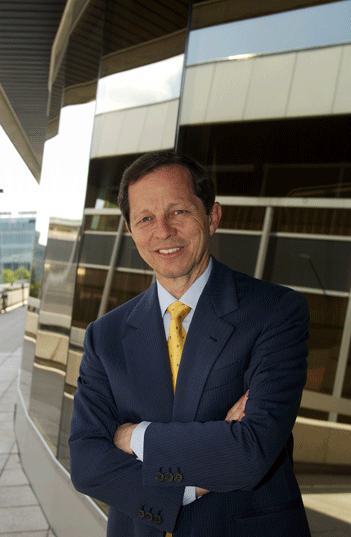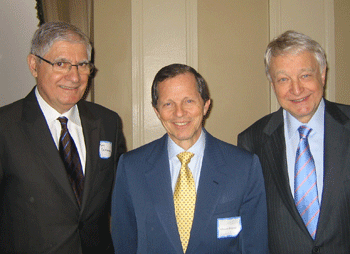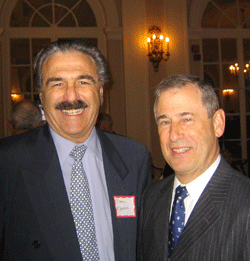Giovanni
Wings A Humdinger
 Giovanni Bisignani, Director General
and CEO, IATA delivered a speech at The Wings Club in New York yesterday.
Giovanni Bisignani, Director General
and CEO, IATA delivered a speech at The Wings Club in New York yesterday.
When you meet the DG you notice right away that
he is not a particularly big guy.
Mr. Bisignani is compact with a wiry build and
while he speaks he seems to move around a lot.
He is always thinking as he talks and it is obvious
he means what he says.
No doubt Giovanni Bisignani faces big challenges
just as commercial aviation is about to emerge into some kind of profit
sunshine in 2007, after one more year of predicted losses in 2006.
The trick will be for this one-time Alitalia CEO
who now heads up the biggest commercial aviation organization in the world
to somehow address a myriad of direct problems that confront the 265 worldwide
members of IATA.
Watching Giovanni Bisignani deliver this speech
was an education in itself.
The man is so into what he is saying and so very
ebullient about the airline business.
He brings a sense of future, an appreciation of
the past and an edge of excitement to his address.
Lots of people give speeches, but few make the
listener feel like they are hearing the untreated truth in an intimate
briefing.
There is nothing “canned” or “pre-packaged”
about Giovanni Bisignani.
Aviation despite all its other problems has caught a break here.
I looked again and realized that this gentleman
was the biggest guy in the room.
Here are some highlights:
“I believe that there is a new optimism
in the industry.
IATA just released results from our new CFO Confidence
Survey.
Over half saw an improvement in profitability
during the first quarter of 2006 and 70% expect improvements in profitability
over the next year.
Stronger prospects are based on efficiency gains
that have averaged 4% per year and market growth which is expected to
be in the 6% range.
IATA’s outlook is more optimistic.
Our 2007 profit projection increased from US$6
billion to US$7.2 billion.
Good news—but save the champagne.
A 3% return on capital for a US$400 billion industry
does not even cover the cost of capital, and over-capacity is always a
risk following record aircraft orders.
Fortunately, the fleet replacement rate will peak
at 5.7% in the next two years—below the 7% rates of previous peaks.
Careful matching of capacity to demand will be
critical.
The industry’s fuel bill went from US$44
billion in 2003 to US$92 billion last year.
High fuel prices are a long-term reality.
Refinery margins on jet fuel more than doubled—from
US$6 to US$16 per barrel—in the last two years.
This was a US$14 billion gift from the aviation
industry
Instead of investing in new capacity, over the
next two years the oil companies will return US$250 billion to their shareholders.
Governments must encourage investment in refinery
capacity and support research into alternative fuel sources
China and India are rising stars.
China’s double-digit growth is impressive.
It is supported by an effective set of government
policies that consolidated and strengthened local carriers liberalized
to improve service levels with competition and built infrastructure to
keep pace with demand.
The sleeping giant of India is waking-up quickly.
From 2 state-owned carriers to more than a dozen
in less than ten years, today India has over 330 aircraft on order—more
than the existing fleet of 210
Airport infrastructure could be the Achilles heel.
If we do not upgrade quickly, a great start will
end in failure
The IATA Operational Safety Audit (IOSA)—the
first global standard for airline safety management—started in 2003.
IOSA standards are the industry’s best practices
that raise the bar on safety.
We launched and funded a Partnership for Safety
to help our members.
Our first target is Africa where the accident
rate is 12 times the global average
By 2007, IOSA will be a condition of IATA membership—further
transforming IATA into a quality association.
Our Simplifying the Business project is the cornerstone
with five core programs:
100% e-ticketing by the end of 2007; taking the paper out of air freight;
and improving passenger processing with bar coded boarding passes; Common
use kiosks for check-in and radio frequency identification for baggage
management round out that effort.
In total these programs will deliver US$6.5 billion in savings each year.
Looking ahead efficiency is a matter of survival.
We have no patience for inefficiency among our
monopoly suppliers.

Three For New York
Left to Right Tony Calabrese, President, Cargo Network Services;
Giovanni Bisignani, Director General and CEO, IATA and Guenter Rohrmann,
Chief Operating Officer-Emerging Markets, DHL just prior to the
IATA Director General’s dramatic speech as global aviation
leaders gathered at The Wings Club March 22.
|
Aeroports de Paris will increase
charges by 5% per year for the next five years—following a 26.5%
increase over the last five.
San Francisco Airport earned an IATA Eagle Award
in 2003 for their efficiency improvements
But others are not matching the efficiency gains
of their airport customers.
The Port Authority of New York and New Jersey
is case in point.
Newark is the most expensive airport in the world
and JFK is number five
Service levels certainly do not justify costs
And the lack of transparency, political interference
and cross-subsidization make benchmarking impossible.
Deregulation was born in America almost three
decades ago and it changed our industry forever.
Unfortunately—and despite many opportunities—the
U.S. (and I would say Europe also) have lost leadership.
Look at the situation with respect to security
Four years after September 11 security is still
a mess.
Security levels are higher—no doubt.
But we still confuse effectiveness with inconvenience
and unilateral actions with leadership.
We need to work on global standards and cooperation
including harmonization of U.S. security requirements with privacy laws
in Europe and elsewhere,mutual recognition of baggage and cargo screening
and standardization of information requirements among U.S. government
agencies.

Newly named EL AL General Manager-Cargo North America, and
a pioneer of the form Isaac Nijankin meets Airports Council International
Director General Robert J. Aaronson. Mr. Aaronson discussed an upcoming
ACI event in cooperation with IATA (and others) as ACI steps out
on 25-26 April 2006 in Geneva, Switzerland at the second Aviation
& Environment Summit and Exhibition.
"The first Summit (March 2005) was unparalleled, since never
before had over 300 global aviation industrywide leaders come together
to discuss environmental matters." Topics include fuel, local
emissions, noise and technology debated through presentations, panel
session and case studies.
More@ www.airports.org.
|
Politics and fear must not dominate
the agenda.
And security is too important to waste time and
resources battling red tape.
We need faster action.
Air travel is at risk of collapsing under the
weight of massive taxation.
The U.S. has been helpful in resisting French
President Chirac’s misguided idea to tax aviation to help the developing
world.
It is clear that making air travel more expensive
will not help developing nations.
But we have problems in the U.S. too.
The average tax on a US$200 ticket sold is still
26%
We are being taxed at the rate of alcohol or tobacco—a
US$15.8 billion rip-off
Governments must understand that we are a mass
transit system carrying 2 billion passengers each year.
We should not be taxed as if we were a luxury
of the rich. It is time to bring some common sense to taxation.
Governments must get out of our business.
Governments must play an effective role in safety,
security and regulation of monopolies.
 Newark
is the most expensive airport in the world and JFK is number five.
Service levels certainly do not justify costs. Newark
is the most expensive airport in the world and JFK is number five.
Service levels certainly do not justify costs.
|
Our industry is in an emergency
situation and the best thing that governments can do is to let airlines
run their businesses like businesses.
Consolidation is not a dirty word.
Airlines need the same access to global capital
that other industries take for granted.
Regulators have no problem with an auto industry
that is dominated by a handful of global players.
Why is air transport different?
The Flags on the tails of our aircraft are sinking
the industry.
The NPRM on increasing foreign ownership opportunities
is just a first step in the right direction.
It may have a substantial role if it helps facilitate
the U.S.-EU agreement on open skies with regulatory convergence.
But it must pave the way to full liberalization
of markets and ownership—the final goal.
Remember there is no alibi for not moving forward.
The U.S. and Europe are markets of similar size,
dimension, level of development, technology etc.
Combined they represent nearly two thirds of aviation
so a change here is a real signal to the world.
But if the agreement fails, it could be the last
opportunity for the U.S. and Europe to regain leadership.
The populations of China and India combined are
4 times that of the U.S. and Europe.
Their industries are developing rapidly with modern
rules of the game.
Already China is the fourth largest economy in
the world.
Both China and India have liberalization at the
core of their development policies.
Governments must have the vision to foresee a
world where air transport is a business like any other serving markets
where they exist.”
(Geoffrey Arend)
|



